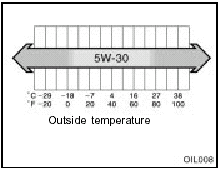 Toyota Yaris: Service specifications
Toyota Yaris: Service specifications
ENGINE
Valve clearance (engine cold), mm (in.): Intake 0.15—0.25 (0.006—0.010).
Exhaust 0.25—0.35 (0.010—0.014).
Spark plug type: DENSO SK16R11.
NGK IFR5A11.
Spark plug gap, mm(in.):
1.1 (0.043).
Drive belt tension measured with Boroughs drive belt tension gauge No. BT-33-73F (used belt), lbf: Generator belt 100 20.
ENGINE LUBRICATION
Oil capacity (drain and refill), L (qt., Imp. qt.): With filter 3.7 (3.9, 3.3).
Without filter 3.4 (3.6, 3.0).
“Toyota Genuine Motor Oil” is used in your Toyota vehicle. Use Toyota approved “Toyota Genuine Motor Oil” or equivalent to satisfy the following grade and viscosity.
Oil grade: ILSAC multigrade engine oil.
Please contact your Toyota dealer for further details.
Recommended oil viscosity: SAE 5W-30.

COOLING SYSTEM
Total capacity, L (qt., Imp. qt.): Manual transmission 4.8 (5.1, 4.2).
Automatic transmission 4.7 (5.0, 4.1).
Coolant type: “Toyota Super Long Life Coolant” is used in your Toyota vehicle at factory fill. In order to avoid technical problems, only use “Toyota Super Long Life Coolant” or similar high quality ethylene glycol based non-silicate, non-amine, non- nitrite, and non-borate coolant with long-life hybrid organic acid technology.
(Coolant with long-life hybrid organic acid technology is a combination of low phosphates and organic acids.).
Do not use plain water alone.
Please contact your Toyota dealer for further details.
BATTERY
Open voltage* at 20 C (68 F):
12.6—12.8 V Fully charged.
12.2—12.4 V Half charged.
11.8—12.0 V Discharged.
*: Voltage that is checked 20 minutes after the key is removed with all the lights turned off.
Charging rates: 5 A max.
CLUTCH
Pedal free play, mm (in.): 5—15 (0.2—0.6)
Fluid type: SAE J1703 or FMVSS No. 116 DOT 3
MANUAL TRANSAXLE
Oil capacity, L (qt., Imp. qt.):
1.9 (2.0, 1.7)
Oil type: Gear oil API GL-4 or GL-5
Recommended oil viscosity: SAE 75W-90
AUTOMATIC TRANSAXLE
Fluid capacity (drain and refill), L (qt., Imp. qt.): 2.5 (2.6, 2.2)
Fluid type: Toyota Genuine ATF Type WS
Change automatic transmission fluid only as necessary.
Generally, it is necessary to change automatic transmission fluid only if your vehicle is driven under one of the Special Operating Conditions listed in your “Scheduled Maintenance Guide” or “Owner’s Manual Supplement”. When changing the automatic transmission fluid, use only “Toyota Genuine ATF Type WS” (ATF JWS3324 or NWS9638) to aid in assuring maximum transaxle performance.
Notice: Using automatic transmission fluid other than “Toyota Genuine ATF Type WS” may cause deterioration in shift quality, locking up of your transmission accompanied by vibration, and ultimately damage the automatic transmission of your vehicle.
Please contact your Toyota dealer for further details.
BRAKES
Minimum pedal clearance when depressed with the pressure of 300 N (30 kgf, 66 lbf) with the engine running, mm (in.): With anti-lock brake system 73 (2.9).
Without anti-lock brake system 70 (2.8).
Pedal free play, mm (in.): 1—6 (0.04—0.24)
Pad wear limit, mm (in.):
1.0 (0.04)
Lining wear limit, mm (in.):
1.0 (0.04)
Parking brake adjustment when pulled with the force of 200 N (20 kgf, 45 lbf): 6—9 clicks
Fluid type: SAE J1703 or FMVSS No. 116 DOT 3
STEERING
Wheel free play: Less than 30 mm (1.2 in.)
 Fuel
Fuel
Fuel type: Unleaded gasoline, Octane Rating 87 (Research Octane Number 91) or
higher Fuel tank capacity, L (gal., Imp. gal.): 42 (11.1, 9.2) ...
 Tires
Tires
Tire size and cold tire inflation pressure:
Front and rear
kPa (kgf/cm2 or bar, psi)
Tire size
Front
Rear
Wheel size
P175/65R14 81S
220 (2.2, 32)
22 ...
See also:
Front body pillar (CUT)
REPLACEMENT
With the cowl top side upper panel removed.
REMOVAL
INSTALLATION
Temporarily install the new parts and measure each part of the new parts in accordance
with the body dimension ...
Engine (ignition) switch
■ Starting the engine
Vehicles with an automatic transmission
Check that the parking brake is set.
Check that the shift lever is set in P.
Firmly depress the brake pedal.
Turn the ...
Power outlet
The power outlet is designed for power supply for car accessories. To use
the power outlet, open as shown in the illustration.
The key must be in the “ACC” or “ON” position for the powe ...
